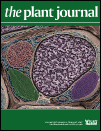View Item
- xmlui.general.dspace_homeCentros e Institutos de InvestigaciónCICVyA. Centro de Investigación en Ciencias Veterinarias y AgronómicasInstituto de BiotecnologíaArtículos científicosxmlui.ArtifactBrowser.ItemViewer.trail
- DSpace Home
- Centros e Institutos de Investigación
- CICVyA. Centro de Investigación en Ciencias Veterinarias y Agronómicas
- Instituto de Biotecnología
- Artículos científicos
- View Item
TMV induces RNA decay pathways to modulate gene silencing and disease symptoms
Abstract
RNA decay pathways comprise a combination of RNA degradation mechanisms that are implicated in gene expression, development and defense responses in eukaryotes. These mechanisms are known as the RNA Quality Control or RQC pathways. In plants, another important RNA degradation mechanism is the posttranscriptional gene silencing (PTGS) mediated by small RNAs (siRNAs). Notably, the RQC pathway antagonizes PTGS by preventing the entry of dysfunctional mRNAs
[ver mas...]
RNA decay pathways comprise a combination of RNA degradation mechanisms that are implicated in gene expression, development and defense responses in eukaryotes. These mechanisms are known as the RNA Quality Control or RQC pathways. In plants, another important RNA degradation mechanism is the posttranscriptional gene silencing (PTGS) mediated by small RNAs (siRNAs). Notably, the RQC pathway antagonizes PTGS by preventing the entry of dysfunctional mRNAs into the silencing pathway to avoid global degradation of mRNA by siRNAs. Viral transcripts must evade RNA degrading mechanisms, thus viruses encode PTGS suppressor proteins to counteract viral RNA silencing. Here, we demonstrate that tobacco plants infected with TMV and transgenic lines expressing TMV MP and CP (coat protein) proteins (which are not linked to the suppression of silencing) display increased transcriptional levels of RNA decay genes.
These plants also showed accumulation of cytoplasmic RNA granules with altered structure, increased rates of RNA decay for transgenes and defective transgene PTGS amplification. Furthermore, knockdown of RRP41 or RRP43 RNA exosome components led to lower levels of TMV accumulation with milder symptoms
after infection, several developmental defects and miRNA deregulation. Thus, we propose that TMV proteins induce RNA decay pathways (in particular exosome components) to impair antiviral PTGS and this defensive mechanism would constitute an additional counter-defense strategy that lead to disease
symptoms.
[Cerrar]

Author
Fuente
Plant journal 89 (1) : 73–84. (2017)
Date
2017
ISSN
1365-313X (Online)
Formato
pdf
Tipo de documento
article
Palabras Claves
Derechos de acceso
Abierto
 Excepto donde se diga explicitamente, este item se publica bajo la siguiente descripción: Creative Commons Attribution-NonCommercial-ShareAlike 2.5 Unported (CC BY-NC-SA 2.5)
Excepto donde se diga explicitamente, este item se publica bajo la siguiente descripción: Creative Commons Attribution-NonCommercial-ShareAlike 2.5 Unported (CC BY-NC-SA 2.5)


